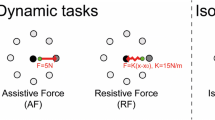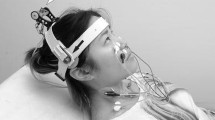Summary
A musculoskeletal system with more muscles than there are motions could be programmed in alternative ways to produce a single movement. In this case, the muscles would have the potential to be maximally responsive in multiple directions rather than responding preferentially in a single direction. To determine the response patterns of muscles in the head-neck motor system, the simultaneous activation of four of the 23 neck muscles acting on the head was recorded with both surface and intramuscular electrodes. Fifteen human subjects were tested during an isometric head stabilization task. When the EMG response patterns were plotted, each muscle demonstrated a preferred direction of activation. This preferred activation direction was consistent in all of the subjects for three of the muscles tested. The fourth muscle, splenius, was preferentially activated during neck flexion in half of the subjects and during neck extension in the other half. Increasing the force parameters of the task suggested a linear relationship between force and the EMG output in the preferred response directions. Responses in the nonpreferred directions were produced by a nonlinear change in EMG activation of the muscle. This finding could have implications for theories of how reciprocal activation and cocontraction patterns of response are elicited. Results from this study, that the CNS programs neck muscles to respond in specific orientations rather than generating an infinite variety of muscle patterns, are in agreement with our findings in the cat.
Similar content being viewed by others
References
Baker J, Goldberg J, Peterson B (1985) Spatial and temporal response properties of the vestibulocollic reflex in decerebrate cats. J Neurophysiol 54: 735–756
Baker J, Wickland C (1988) Kinematic properties of the vestibulocollic reflex. In: Peterson BW, Richmond FJ (eds) Control of head movement. Oxford University Press, New York, pp 167–177
Buchanan TS, Almdale DPI, Lewis JL, Rymer WZ (1986) Characteristics of synergic relations during isometric contractions of human elbow muscles. J Neurophysiol 56: 1225–1241
Crowninshield RD, Brand RA (1981) A physiologically based criteria of muscle force prediction in locomotion. J Biomech 14: 793–801
Daniels L, Worthingham C (1972) Muscle testing: techniques of manual examination, 3rd edn. Saunders, Philadelphia, pp 16–20
DeLuca CJ, LeFever RS, McCue MP, Xenakis AP (1982) Behaviour of human motor units in different muscles during linearly varying contractions. J Physiol (Lond) 329: 113–128
Denier van der Gon JJ, ter Haar Romeny BM, van Juylen EJ (1985) Behaviour of motor units of human arm muscles: differences between slow isometric contraction and relaxation. J Physiol (Lond) 359: 107–118
Edwards AL (1968) Experimental design in psychological research 4th ed. Holt, Rinehart, Winston, New York, pp 146–147
Fel'dman AG (1974) Change in the length of the muscle as a consequence of a shift in equilibrium in the muscle load system. Biofizika 19: 534–538
Fel'dman AG (1980) Superposition of motor programs. II. Rapid forearm flexion in man. Neuroscience 5: 91–95
Fel'dman AG (1987) Once more on the equilibrium-point hypothesis (gamma model) for motor control. J Motor Behav 18: 17–54
Goldberg J, Peterson BW (1986) Reflex and mechanical contributions to head stabilization in alert cats. J Neurophysiol 56: 857–875
Gowitzke BA, Milner M (1980) Understanding the scientific basis of human movement. Williams and Wilkins, Baltimore, pp 11–22
Ikai M, Fukunaga T (1968) Calculation of muscle strength per unit cross-sectional area of human muscle by means of ultrasonic measurement. Int Z Angew Physiol Einschl Arbeitsphysiol 26: 26–32
Kapandji IA (1974) The physiology of the joints, 2nd ed. Churchill Livingstone, New York, pp 225–240
Keshner EA, Peterson BW (1988) Motor control strategies underlying head stabilization and voluntary head movements in humans and cats. Progress in Brain Res 76: 329–339
Lockhart RD, Hamilton GF, Fyfe FW (1972) Anatomy of the human body. Lippincott, New York, pp 153–172
Nicholls TR, Houk JC (1976) Improvement in linearity and regulation of stiffness that results from actions of the stretch reflex. J Neurophysiol 39: 119–142
Outerbridge JS, Melvill Jones G (1971) Reflex vestibular control of head movements in man. Aerospace Med 42: 935–940
Sherk HH, Parke WW (1983) Normal adult anatomy. In: The Cervical Spine Research Society (ed) The cervical spine. Lippincott, New York, pp 8–22
Takebe K, Vitti M, Basmajian JV (1974) The functions of semispinalis capitis and splenius capitis muscles: an electromyographic study. Anat Rec 179: 477–480
ter Haar Romeny BM, Denier van der Gon JJ, Gielen CCAM (1982) Changes in recruitment order of motor units in the human biceps muscle. Exp Neurol 78: 360–368
Vidal PP, Graf W, Berthoz A (1986) The orientation of the cervical vertebral column in unrestrained awake animals. I. Resting position. Exp Brain Res 61: 549–559
Vitti M, Fujiwara M, Basmajian JV, Iida M (1973) The integrated roles of longus colli and sternocleidomastoid muscles: an electromyographic study. Anat Rec 177: 471–484
Zangemeister WH, Stark L, Meienberg O, Waite T (1982) Neural control of head rotation: electromyographic evidence. J Neurol Sci 55: 1–14
Author information
Authors and Affiliations
Rights and permissions
About this article
Cite this article
Keshner, E.A., Campbell, D., Katz, R.T. et al. Neck muscle activation patterns in humans during isometric head stabilization. Exp Brain Res 75, 335–344 (1989). https://doi.org/10.1007/BF00247939
Received:
Accepted:
Issue Date:
DOI: https://doi.org/10.1007/BF00247939




